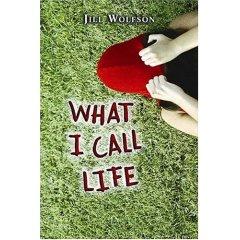 I'm getting some great feedback on my new novel for middle-readers. *Starred review from Booklist Nov. 2005
I'm getting some great feedback on my new novel for middle-readers. *Starred review from Booklist Nov. 2005"After her mother has a breakdown in the middle of the public library, Cal is taken to live in a group home, which houses five other girls from troubled families. The young residents of the orange-colored Pumpkin House wear their wounds inside and out: Whitney is brash, bubbly, and determined to find her long-separated sister; timid Monica is whiny and full of complaints; Fern is an incessant giggler who sports a black eye; quiet, intelligent Amber has pulled every hair from her head, eyebrows, and lashes. Cal feels different. She's sure she is not a whiner, not a fusser; she shows no emotion and she's very organized. After all, she's held herself and her mother together for all of her eleven years. The Knitting Lady, the girls' tiny, elderly guardian, slowly begins the girls' healing process by sharing her love for knitting and storytelling. As the girls experience quiet time, reflection, and bonding with each other and their guardian, the Knitting Lady helps the girls recognize their own goodness and worth.Wolfson paints her characters with delightful authenticity.
Her novel is a treasure of quiet good humor and skillful storytelling that conveys subtle messages about kindness, compassion, and the gift of family regardless of its configuration."--Frances Bradburn
One of the hot new kids’ books at the 2005 Book Expo America –
Publisher’s Weekly
A Junior Library Guild selection. Check it out at
www.juniorlibraryguild.comSEPTEMBER SCHOOL LIBRARY JOURNAL:
Gr 5-8-When her unstable mother has a psychotic episode, Cal is placed in a group home run by an elderly woman called "The Knitting Lady." The 11-year-old's new roommates are four girls, all in different stages of denial about their own situations. Cal, who prides herself on her independence and is fiercely protective of her mother, insists that she'll be going home any day and that what is happening is not at all part of her real life. Meanwhile, time passes, the girls learn to knit, and the Knitting Lady tells stories about two girls from long ago: one who was abandoned at an orphanage by her own mother, and another who was sent west on an orphan train. Set against these narratives, the present-day story involves shifting alliances, a search for a younger sister who may or may not exist, and a clear-eyed view of life in a group home and/or with "fosters" (regarding placements, one girl tells Cal, "Everything gets decided behind your back"). The author has a knack for vivid descriptions, suspenseful plotting, and a clear telling of the stories-within-the-story.
A thoughtful and ultimately hopeful book, this novel has flashes of humor that lighten the sometimes painful events. Not all readers will take to it, but those who do will find it resonant and absorbing.-Lauralyn Persson, Wilmette Public Library, IL
August 15 Kirkus Reviews: Cal Lavender (11) has perfected what she calls "My Face for Unbearably Unpleasant and Embarrassing Situations," which unfortunately is coming in handy following her mother's latest public outburst. While the story never gives Betty, Cal's mother, a specific diagnosis, her mental health causes Cal to be taken into protective custody until such time as Betty is deemed a functioning parent. Assuming that her stay at the group home, dubbed the Pumpkin House, is simply a detour from her real life, Cal initially resists getting to know the other girls. These include Whitney, a girl with an imaginary sister and a motor mouth; Amber, who can't stop pulling out all of her hair; and Monica, who jumps at her own shadow. The head of the group home, simply known as The Knitting Lady, offers pearls of wisdom in the form of stories, offering the girls a glimpse into each other's lives.
While the odd characters are interesting, it's the smart and unique voice that makes this story shine. (Fiction. 10-14)




